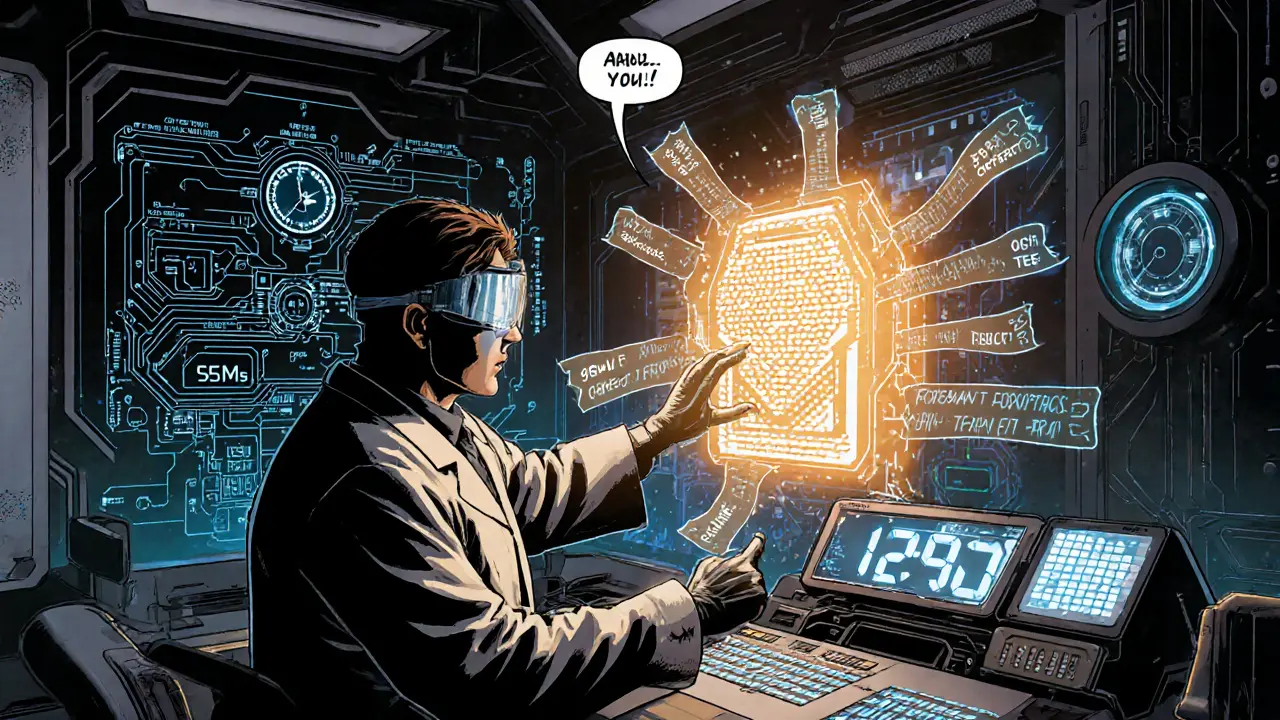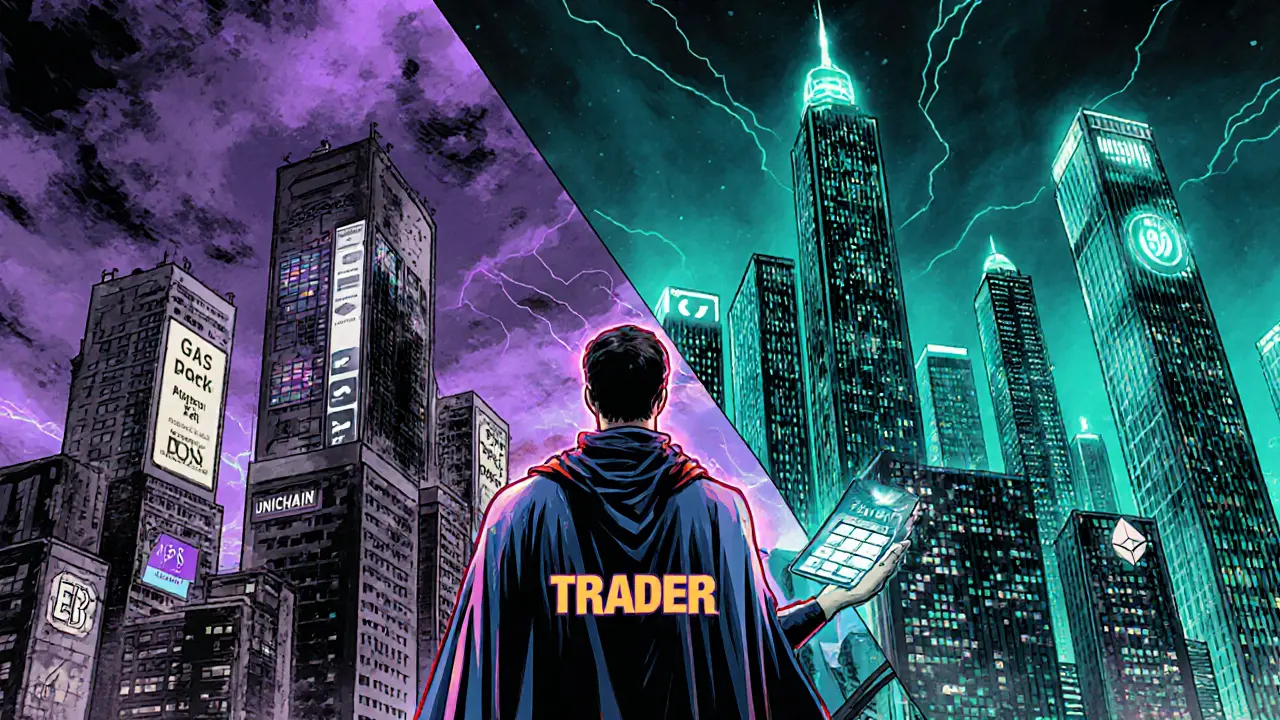Unichain vs Ethereum Fee Calculator
Estimated Monthly Cost Comparison
Fee Comparison Table
| Network | Block Time | Fee (Relative to ETH) | Fault-Prove Model |
|---|---|---|---|
| Ethereum L1 | ≈13 s | 100% | Proof-of-Work → Proof-of-Stake |
| Unichain | ≈1 s (target 250 ms) | ≈5% | Permissionless fault proofs (day 1) |
| Arbitrum | ≈2 s | ≈10% | Optimistic proofs (post-launch) |
| Polygon zkEVM | ≈2 s | ≈8% | Zero-knowledge proofs |
Unichain crypto exchange review
TL;DR - What you need to know
- Unichain is Uniswap Labs’ purpose‑built Layer‑2 rollup, offering ~1‑second blocks and 95% lower fees than Ethereum.
- Uniswap v2 works unchanged on Unichain, so existing UI habits stay the same.
- Trading on Unichain cuts transaction cost to about 5% of Ethereum’s gas price.
- Fee split now sends 20% to Uniswap Labs and 2.5% to the Optimism Collective, with the rest to sequencers.
- Early adoption is strong - >95million testnet txs, 99% uptime, and many projects (USDC, Lido, Circle) already on‑boarded.
Overview of Unichain and Its Place in the DeFi Landscape
When you hear “Unichain is a purpose‑built Layer‑2 rollup created by Uniswap Labs using Optimism’s OP Stack”, imagine a sidechain that talks directly to Ethereum but eliminates the latency and cost that have held DeFi back.
The network launched on 11Feb2025 as a Stage1 optimistic rollup. From day one it ran permissionless fault proofs, a security feature that many newer L2s only add later.
Technical Architecture - How Unichain Gets Its Speed
Unichain inherits the OP Stack from Optimism, which standardises rollup data availability, fraud proofs, and sequencer design across the Superchain ecosystem. The stack enables sub‑second block times (currently ~1s) and plans to push down to 250ms using a Trusted Execution Environment (TEE) built with Flashbots.
During its four‑month testnet, Unichain processed 95million transactions and deployed 14.7million smart contracts, proving it can handle heavy DeFi workloads.
Performance and Fee Comparison
Ethereum’s mainnet finalises a transaction in about 13seconds and charges roughly 20gwei gas (≈$30 at peak). Unichain slashes that to a 1‑second finality and fees that are only 5% of Ethereum’s cost - a 95% reduction.
| Network | Block time | Fee (relative to ETH) | Fault‑proof model |
|---|---|---|---|
| Ethereum L1 | ≈13s | 100% | Proof‑of‑Work → Proof‑of‑Stake |
| Unichain | ≈1s (target 250ms) | ≈5% | Permissionless fault proofs (day1) |
| Arbitrum | ≈2s | ≈10% | Optimistic proofs (post‑launch) |
| Polygon zkEVM | ≈2s | ≈8% | Zero‑knowledge proofs |
Trading on Uniswap v2 - Same UI, Better Experience
For a Uniswap veteran, the transition feels seamless. The familiar Uniswap v2 interface appears on Unichain without any UI redesign. Users simply bridge assets from Ethereum via the supported bridge, then swap, add liquidity, or provide range orders exactly as before.
Because gas is cheap, traders can execute multiple small swaps or re‑balance positions without worrying about fee erosion. Liquidity providers also enjoy higher capital efficiency - the same amount of ETH or USDC yields more realized fees per dollar of locked value.

New Fee Distribution Model
Uniswap Labs revamped its revenue capture. Now Uniswap Labs takes 20% of all fees generated on Unichain. The Optimism Collective receives the larger of 2.5% of gross revenue or 15% of net revenue. The remainder fuels sequencer incentives and will later be routed to UNI token stakers as the network decentralises.
This alignment means UNI holders stand to earn a slice of the massive $2.7billion settlement fee pool that Uniswap has historically generated.
Ecosystem Adoption - Projects That Have Jumped In
During the testnet, over 100 projects experimented on Unichain. Notable early adopters include USDC (Circle), Lido, and the Coinbase bridge. Their participation signals confidence that the rollup can handle high‑value, high‑throughput DeFi protocols.
Liquidity providers have already begun migrating positions, spurred by incentives announced in the Unichain launch roadmap. Early migrators can expect lower impermanent loss risk thanks to reduced fee drag.
Risks, Limitations, and Things to Watch
- Bridge complexity: Moving assets between L1 and L2 still requires a bridge transaction, which can be confusing for newcomers.
- Centralisation lag: While permissionless fault proofs are active, the sequencer is currently run by Uniswap Labs. Full decentralisation depends on future UNI‑governed validator rollout.
- ETH economics shift: Large volumes moving to Unichain could diminish ETH burn revenue, potentially adding upward pressure on ETH’s supply.
Future Roadmap - Where Unichain Is Headed
Short‑term goals focus on TEE‑based block production to reach 250ms finality. Mid‑term, Unichain aims to join the Optimism Superchain’s “single‑block message passing” - a feature that would let contracts on Arbitrum, Optimism, and Unichain communicate instantly.
Long‑term, the network plans to decentralise sequencer responsibilities through UNI token staking, mirroring the model used by other OP‑Stack rollups. The grant fund of $36.81million held by the Uniswap Foundation will fuel developer bounties, ecosystem grants, and cross‑chain tooling.
Bottom Line - Is Unichain Worth Your Time?
If you’re already trading on Uniswap v2 and are tired of high gas fees, Unichain offers a drop‑in upgrade with massive cost savings and speed gains. New users gain a modern entry point to DeFi without learning a completely new UI.
Keep an eye on bridge UX and the upcoming decentralisation milestones - those will determine how sustainable the advantages remain as the ecosystem matures.
Frequently Asked Questions
How do I move assets from Ethereum to Unichain?
Use the official Uniswap bridge or any supported third‑party bridge (e.g., Hop Protocol). Connect your wallet, select the token, specify the amount, and confirm the L1 transaction. The assets appear on Unichain within a few seconds, ready for trading.
Will my existing liquidity positions automatically migrate?
No. You need to withdraw from the Ethereum pool and re‑deposit on the Unichain pool. Uniswap Labs plans migration incentives, such as reduced fees for the first 30days, to ease the transition.
Is Unichain as secure as Ethereum?
Security is high because permissionless fault proofs run from launch. However, the sequencer is still centrally run, so full decentralisation and the associated security guarantees will arrive later.
What tokens are supported on Unichain?
Any ERC‑20 that can be bridged to Unichain works, including major stablecoins (USDC, USDT), ETH‑wrapped tokens, and most DeFi project tokens. The ecosystem is expanding as more protocols launch on the rollup.
Will using Unichain affect my UNI staking rewards?
Yes. As fees flow through Unichain, the 20% share captured by Uniswap Labs eventually gets distributed to UNI stakers, increasing the net APR on the protocol’s treasury.





Anil Paudyal
May 13 2025Looks promissing cheap fees.
Kimberly Gilliam
May 15 2025Wow, Unichain totally flips the script on DeFi fees. The speed is almost unreal and the cost is laughably low. It feels like the whole ecosystem finally got a boost. Everyone's going to be talking about this for months. I can already see the hype building.
Jeannie Conforti
May 17 2025Unichain is a layer‑2 rollup built by Uniswap Labs. It uses the OP Stack to get fast finality. The block time is around one second now. That means trades happen almost instantly. Fees are only about five percent of Ethereum's cost. This makes small swaps viable. Liquidity providers can move capital without worrying about fee drag. The bridge lets you move assets from L1 to L2 in seconds. You just connect your wallet and hit bridge. No fancy UI changes are needed on Uniswap v2. The familiar interface stays the same. Early projects like USDC and Lido already deployed on the network. Testnet showed 95 million transactions in a few months. Security comes from permissionless fault proofs from day one. The sequencer is still run by Uniswap Labs though. Full decentralisation will come later with UNI staking.
tim nelson
May 20 2025I get the excitement but also see the need to watch bridge UX closely. The cheap fees are great for frequent traders. At the same time centralised sequencer raises a few concerns. It’ll be interesting to see how the validator rollout progresses. Overall the trade‑off feels worth it for now.
Zack Mast
May 22 2025While the tech sounds slick, we should ask who really benefits. A rollup built by a US‑based lab could tighten the grip of American players on the global defi stage. The permissionless proofs are a nice touch, yet the sequencer centralisation feels like a hidden leash. History shows that power concentrates when infrastructure is owned by few. Keep an eye on governance, or else we might be trading under a new kind of monopoly.
Dale Breithaupt
May 24 2025Got to say, this is a sweet upgrade for anyone tired of gas gouging. The speed boost feels like a fresh breeze in the defi space.
Rasean Bryant
May 27 2025Absolutely, the reduction to five percent of Ethereum fees opens the door for micro‑trading strategies that were previously uneconomical. By keeping the UI identical, user adoption barriers are minimal, which should accelerate liquidity growth across the board.
Angie Food
May 29 2025I doubt this hype is justified; cheap fees often mask hidden risks. The bridge could become a single point of failure everyone ignores.
Jonathan Tsilimos
May 31 2025From a protocol engineering perspective the adoption of the OP‑Stack introduces modularity and composability, facilitating cross‑rollup interoperability. However, the current fault‑proof latency parameters may impose a throughput ceiling that could challenge high‑frequency arbitrageurs.
jeffrey najar
June 3 2025The seamless UI transition means users don’t have to relearn anything, which lowers friction dramatically. Plus the fee model reallocates revenue to UNI stakers, aligning incentives across the ecosystem.
Rochelle Gamauf
June 5 2025Indeed, the redistribution mechanism reflects a sophisticated economic design, yet one must scrutinize the 20% capture by Uniswap Labs for potential centralization of profit streams. Such concentration could undermine the purported decentralization ethos.
Jerry Cassandro
June 7 2025The roadmap aims to expand token support beyond the major stablecoins, which will help developers plan integrations more effectively.
Parker DeWitt
June 10 2025Sure, more tokens sound good 😏 but every new asset adds surface area for exploits. Keep the audits tight, or the whole thing could crumble.
Allie Smith
June 12 2025Sometimes the simplest upgrades hide the deepest insights, like a quiet river shaping a canyon over time. Unichain feels like that gentle force, reshaping defi without loud fanfare.
Lexie Ludens
June 14 2025Oh great, another shiny layer‑2 to distract us while the foundations shake! We’ll be dancing on a house of cards if the bridges falter, and the drama will be endless.
Aaron Casey
June 17 2025From a systems architecture lens, integrating a TEE‑based block production engine could push finality into the sub‑second regime, which is a game‑changer for latency‑sensitive DeFi primitives like flash loans.
Leah Whitney
June 19 2025I appreciate the clear breakdown of fee distribution; it makes it easier for community members to understand how their staking rewards might evolve as volume shifts to Unichain.
Lisa Stark
June 21 2025In the grand tapestry of blockchain evolution, each layer‑2 adds a new thread, weaving together speed, cost, and security into a more resilient fabric.